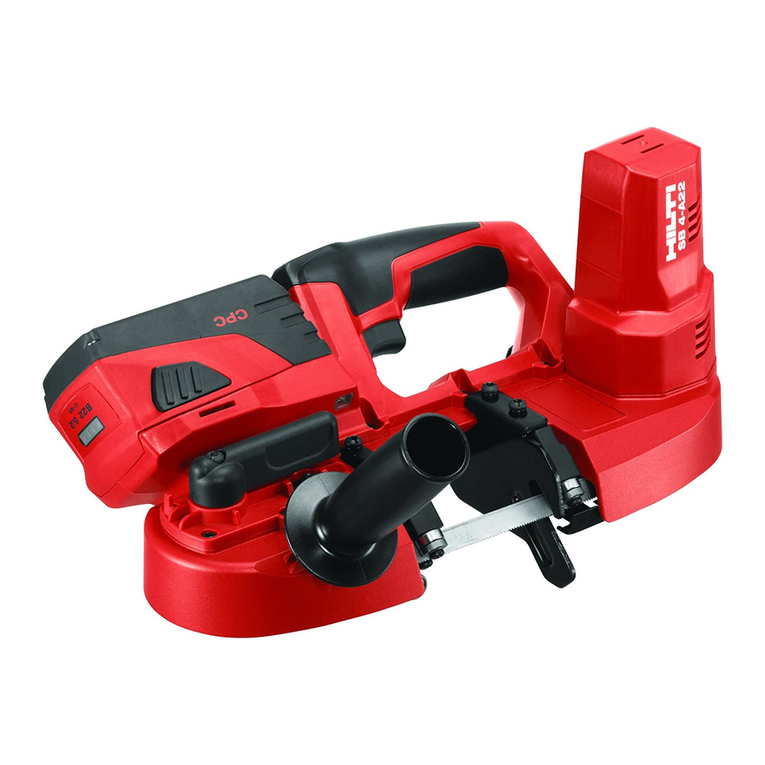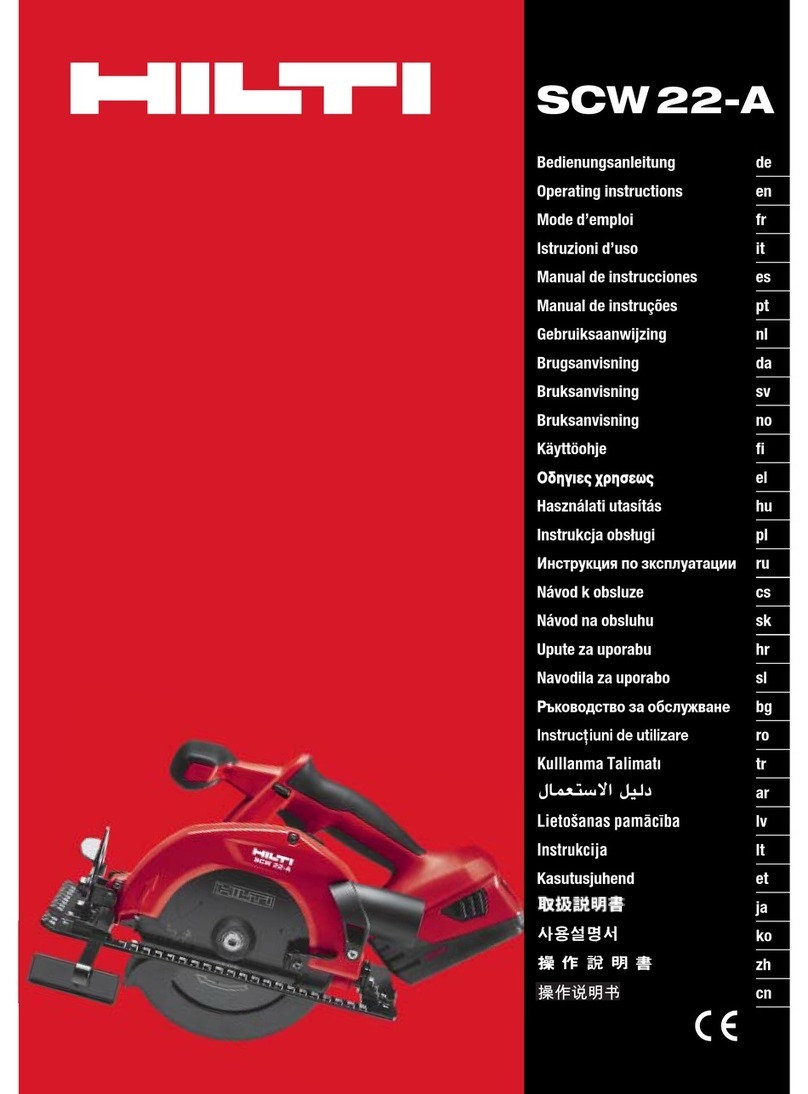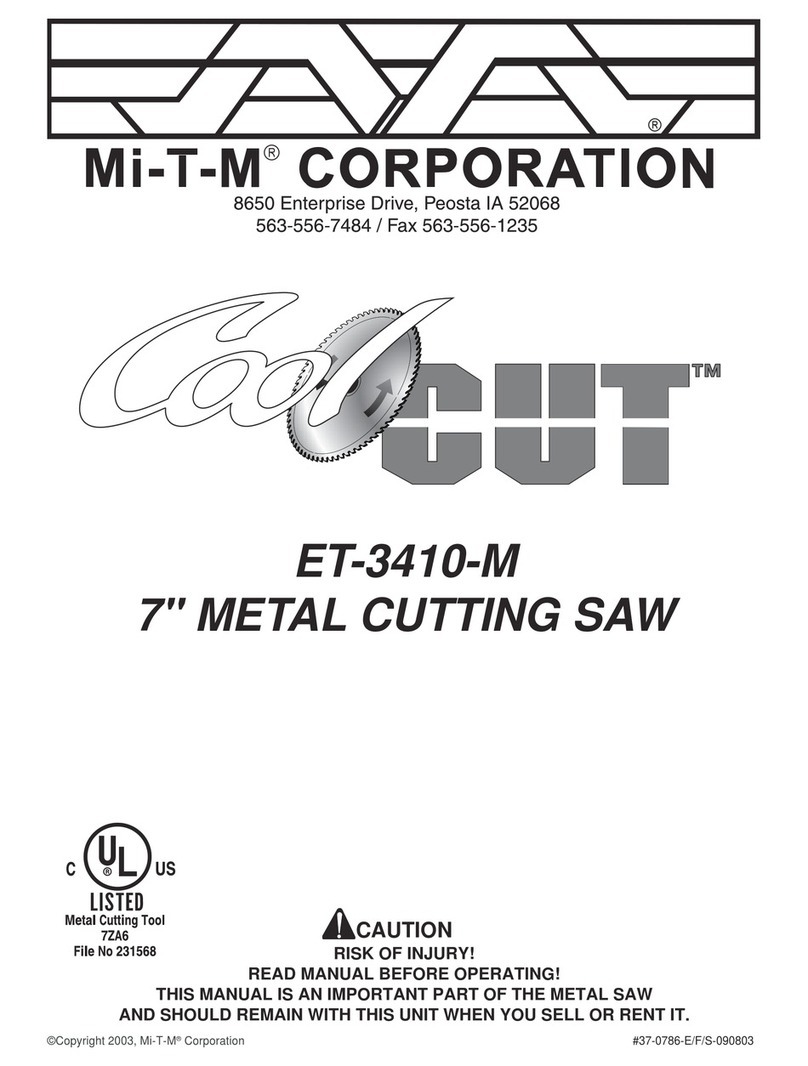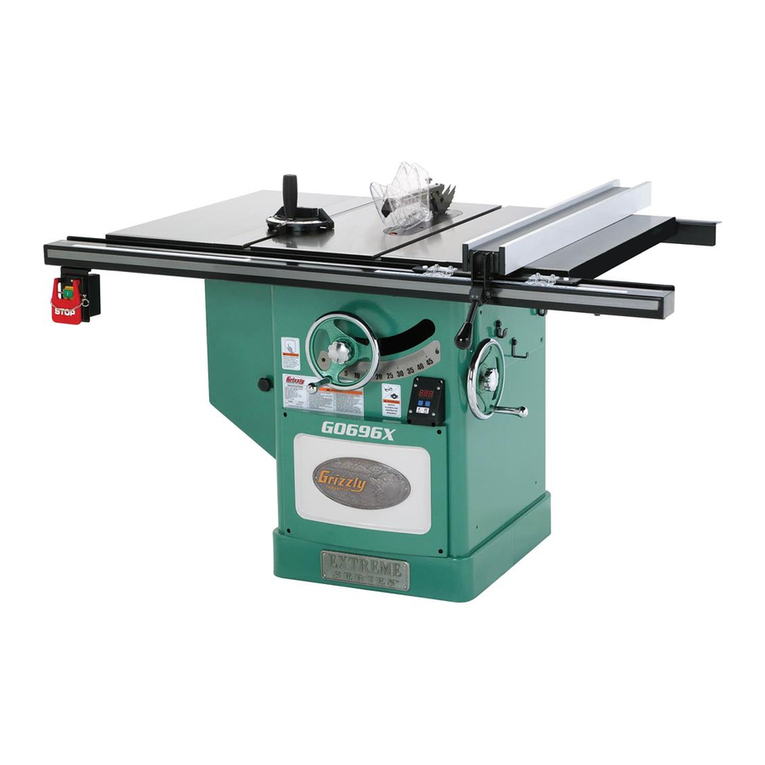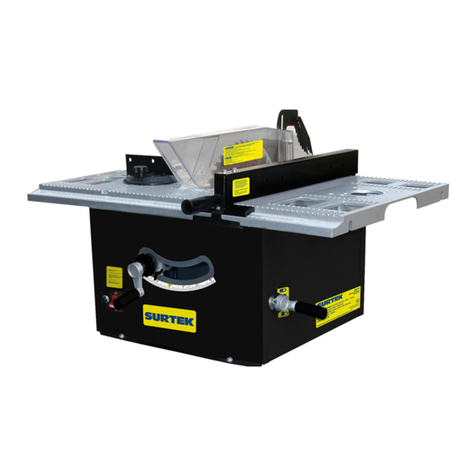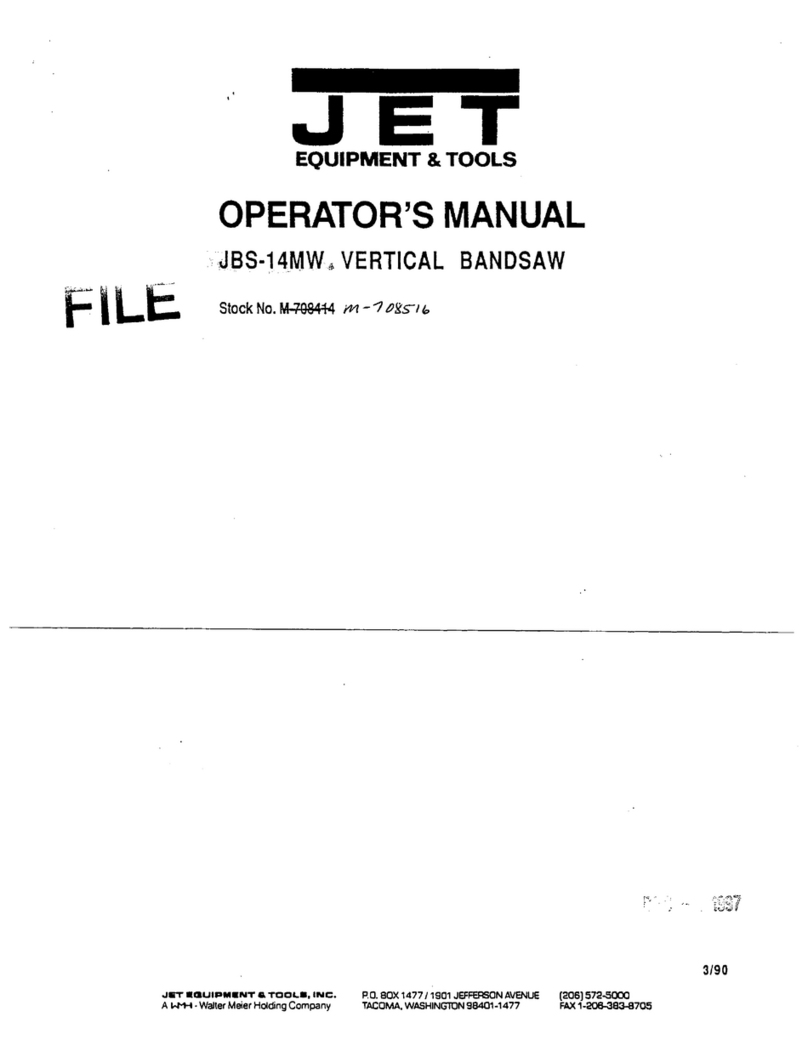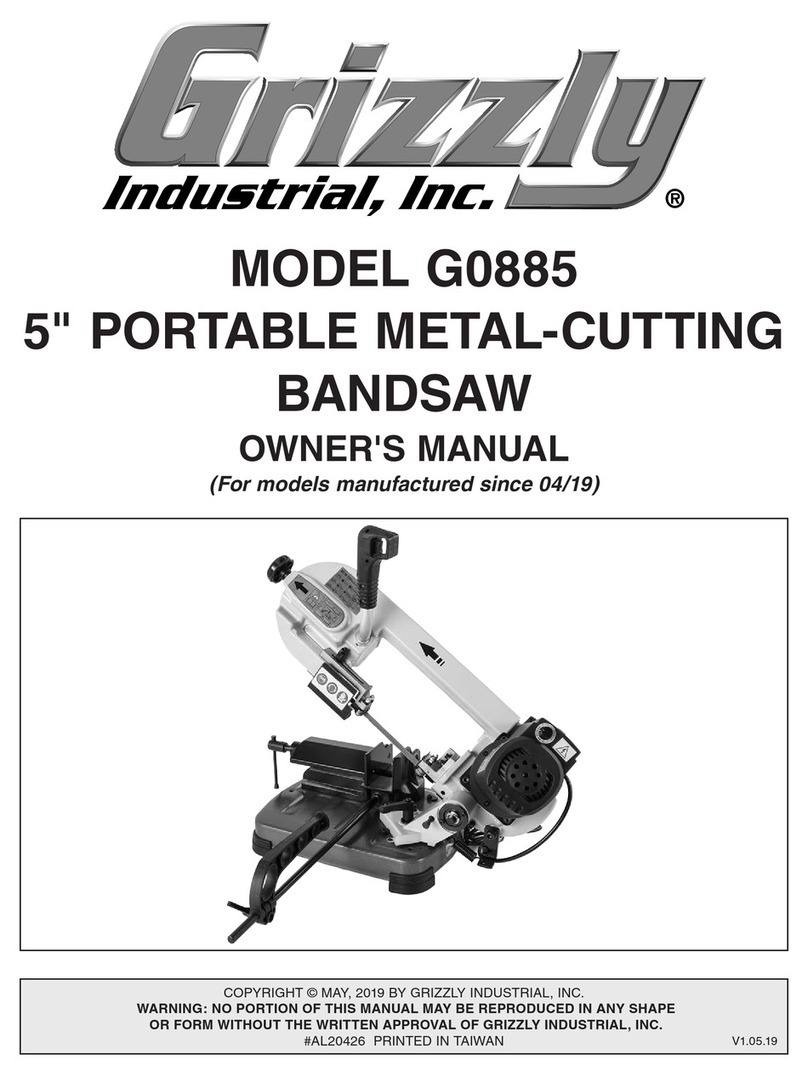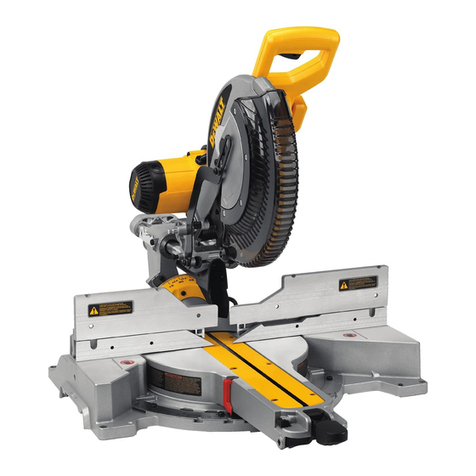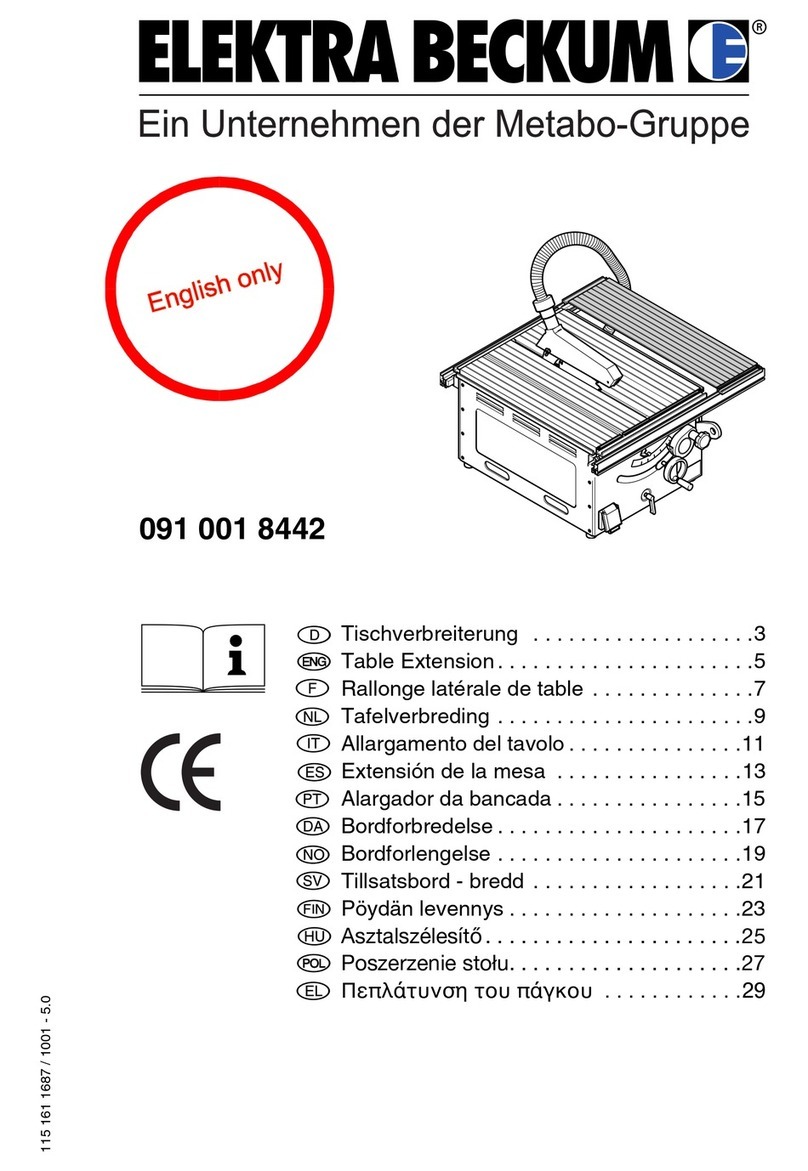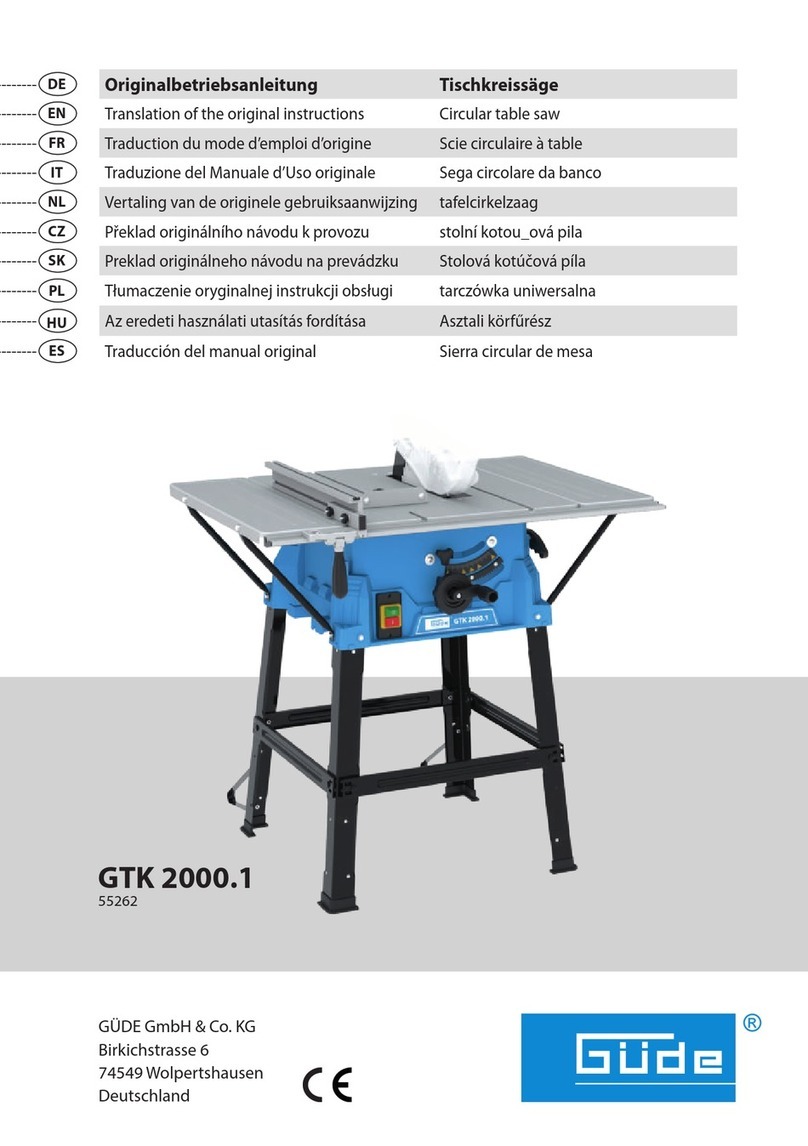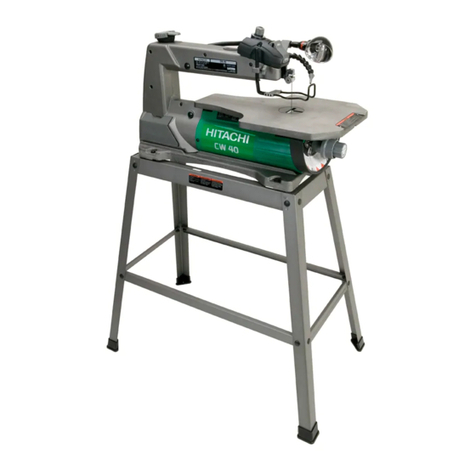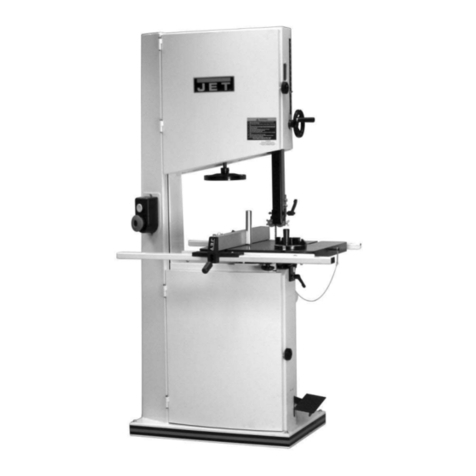Hilti SCM 22-A User manual

1
Printed: 01.09.2017 | Doc-Nr: PUB / 5292940 / 000 / 00Printed: 01.09.2017 | Doc-Nr: PUB / 5292940 / 000 / 01

2
3
4
5
Printed: 01.09.2017 | Doc-Nr: PUB / 5292940 / 000 / 00Printed: 01.09.2017 | Doc-Nr: PUB / 5292940 / 000 / 01

6
7
8
9
Printed: 01.09.2017 | Doc-Nr: PUB / 5292940 / 000 / 00Printed: 01.09.2017 | Doc-Nr: PUB / 5292940 / 000 / 01

SCM 22-A
en Originaloperatinginstructions....................................... 1
fr Moded'emploioriginal ........................................... 12
es Manualdeinstruccionesoriginal .................................... 23
pt Manualdeinstruçõesoriginal ...................................... 34
Printed: 01.09.2017 | Doc-Nr: PUB / 5292940 / 000 / 00Printed: 01.09.2017 | Doc-Nr: PUB / 5292940 / 000 / 01

Printed: 01.09.2017 | Doc-Nr: PUB / 5292940 / 000 / 00Printed: 01.09.2017 | Doc-Nr: PUB / 5292940 / 000 / 01

1
1 Information about the documentation
1.1 About this documentation
• Read this documentation before initial operation or use. This is a is a prerequisite for safe, trouble-free
handling and use of the product.
• Observe the safety instructions and warnings in this documentation and on the product.
• Always keep the operating instructions with the product and make sure that the operating instructions
are with the product when it is given to other persons.
1.2 Explanation of symbols used
1.2.1 Warnings
Warnings alert persons to hazards that may occur when handling or using the product. The following signal
words are used in combination with a symbol:
DANGER! Draws attention to an imminent hazard that will lead to serious personal injury or
fatality.
WARNING! Draws attention to a potential hazard that could lead to serious personal injury or
fatality.
CAUTION! Draws attention to a potentially dangerous situation that could lead to minor personal
injury or material damage.
1.2.2 Symbols in the documentation
The following symbols are used in this document:
Read the operating instructions before use
Instructions for use and other useful information
1.2.3 Symbols in the illustrations
The following symbols are used in illustrations:
These numbers refer to the corresponding illustrations found at the beginning of these operating
instructions.
The numbering reflects the sequence of operations shown in the illustrations and may deviate
from the steps described in the text.
Item reference numbers are used in the overview illustration and refer to the numbers used in
the key in the product overview section.
This symbol is intended to draw special attention to certain points when handling the product.
1.3 Product-dependent symbols
1.3.1 Symbols
The following symbols are used on the product:
Rated speed under no load
Direct current (DC)
Revolutions per minute
Saw blade
1.4 Product information
Hilti products are designed for professional use and may be operated, serviced and maintained only by
trained, authorized personnel. This personnel must be informed of any particular hazards that may be
Printed: 01.09.2017 | Doc-Nr: PUB / 5292940 / 000 / 00Printed: 01.09.2017 | Doc-Nr: PUB / 5292940 / 000 / 01

2
encountered. The product and its ancillary equipment may present hazards when used incorrectly by
untrained personnel or when used not as directed.
The type designation and serial number are printed on the type identification plate.
▶Write down the serial number in the table below. You will be required to state the product details when
contacting Hilti Service or your local Hilti organization to inquire about the product.
Product information
Type: SCM 22A
Generation: 01
Serial no.:
2 Safety
2.1 General safety precautions for power tools
WARNING! Read all safety precautions and other instructions. Failure to observe the safety
precautions and other instructions may result in electric shock, fire and/or serious injury.
Keep all safety precautions and instructions for future reference.
Working area safety
▶Keep your working area clean and well lit. Cluttered or dark working areas can cause accidents.
▶Do not operate the power tool in explosive atmospheres, such as in the presence of flammable
liquids, gases or dust. Power tools create sparks which may ignite the dust or fumes.
▶Keep bystanders, children and visitors away while operating the power tool. Distractions may cause
you to lose control of the tool.
Electrical safety
▶Do not expose the power tool to rain or wet conditions. Water entering a power tool will increase the
risk of electric shock.
▶Do not allow your body to come into contact with grounded surfaces such as pipes, radiators,
ovens and refrigerators. There is an increased risk of electric shock if your body is grounded.
Personal safety
▶Stay alert, watch what you are doing and use common sense when operating a power tool. Do
not use a power tool while you are tired or under the influence of drugs, alcohol or medication. A
moment of inattention while operating the power tool may result in serious personal injury.
▶Adopt the correct posture when working. Maintain proper footing and balance at all times. This
will allow you to control the power tool better, even in unexpected situations.
▶Wear your personal protective equipment and always wear protective glasses. Depending on the
type of power tool you are using and its purpose, wearing safety equipment such as a dust mask,
slip-resistant safety shoes, a hard hat or hearing protection will reduce the risk of injury.
▶Dress properly. Do not wear loose clothing or jewelry. Keep your hair, clothing and gloves away
from moving parts. Loose clothes, jewelry or long hair may be caught in moving parts.
▶Avoid starting the tool accidentally. Make sure that the power tool is switched off before connecting
it to the battery and before picking it up or carrying it. Carrying power tools with your finger on the
switch or plugging in power tools that are already switched on may cause accidents.
▶Remove accessory tools or wrenches before switching the power tool on. An accessory tool or a
wrench left attached to a rotating part of the power tool may cause personal injury.
▶If devices are provided for connecting dust extraction and collection equipment, make sure these
are connected and used correctly. The use of a dust extraction system can reduce dust-related
hazards.
Using and handling the power tool
▶Do not overload the tool. Use the correct power tool for your application. The correct power tool
will do the job better and more safely within the performance range for which it is designed.
▶Do not use a power tool if it has a faulty on/off switch. Any power tool that cannot be controlled with
the switch is dangerous and must be repaired.
▶Remove the battery from the power tool before making any adjustments, changing accessories or
storing the tool. This precaution reduces the risk of the power tool starting accidentally.
▶Store power tools out of reach of children when not in use. Do not allow persons who are not
familiar with the tool or these instructions to operate it. Power tools are dangerous in the hands of
untrained users.
Printed: 01.09.2017 | Doc-Nr: PUB / 5292940 / 000 / 00Printed: 01.09.2017 | Doc-Nr: PUB / 5292940 / 000 / 01

3
▶Maintain power tools properly. Check that moving parts are in correct working order and do not
jam, and check whether any parts are broken or so damaged that correct operation of the power
tool cannot be guaranteed. If any parts are damaged, have these parts repaired before using the
tool. Many accidents are caused by poorly maintained power tools.
▶Keep cutting tools sharp and clean. Properly maintained tools with sharp cutting edges are less likely
to jam and are easier to control.
Using and handling the cordless power tool
▶Use only the specified batteries in the power tools. Use of any other batteries may present a risk of
injury and fire.
▶Recharge the batteries only with the chargers specified by the manufacturer. A charger that is
suitable for a certain type of battery may present a risk of fire when used with other types of battery.
▶When the battery is not in use, keep it away from other metal objects such as paper clips, coins,
keys, nails, screws, or other small metal objects that could cause bridging between the terminals.
A short circuit between the battery terminals may cause burns or a fire.
▶Liquid may leak from the battery if used incorrectly. Avoid contact with this liquid. Liquid leaking
from the battery may cause skin irritation or burns. If contact accidentally occurs, rinse with water. Seek
medical attention if the liquid comes into contact with the eyes.
2.2 Safety instructions for all saws
Cutting procedures
▶DANGER: Keep hands away from cutting area and the blade. Keep your second hand on
auxiliary handle, or motor housing. If both hands are holding the saw, they cannot be cut by the blade.
▶Do not reach underneath the workpiece. The guard cannot protect you from the blade below the
workpiece.
▶Adjust the cutting depth to the thickness of the workpiece. Less than a full tooth of the blade teeth
should be visible below the workpiece.
▶Never hold piece being cut in your hands or across your leg. Secure the workpiece to a stable
platform. It is important to support the work properly to minimize body exposure, blade binding, or loss
of control.
▶Hold the power tool by insulated gripping surfaces only, when performing an operation where the
cutting tool may contact hidden wiring. Contact with a "live" wire will also make exposed metal parts
of the power tool "live" and could give the operator an electric shock.
▶When ripping, always use a rip fence or straight edge guide. This improves the accuracy of cut and
reduces the chance of blade binding.
▶Always use blades with correct size and shape (diamond versus round) of arbour holes. Blades
that do not match the mounting hardware of the saw will run eccentrically, causing loss of control.
▶Never use damaged or incorrect blade washers or bolt. The blade washers and bolt were specially
designed for your saw, for optimum performance and safety of operation.
Kickback causes and related warnings
• kickback is a sudden reaction to a pinched, bound or misaligned saw blade, causing an uncontrolled
saw to lift up and out of the workpiece toward the operator;
• when the blade is pinched or bound tightly by the kerf closing down, the blade stalls and the motor
reaction drives the unit rapidly back toward the operator;
• if the blade becomes twisted or misaligned in the cut, the teeth at the back edge of the blade can dig
into the top surface of the wood causing the blade to climb out of the kerf and jump back toward the
operator.
Kickback is the result of saw misuse and/or incorrect operating procedures or conditions and can be avoided
by taking proper precautions as given below.
▶Maintain a firm grip with both hands on the saw and position your arms to resist kickback forces.
Position your body to either side of the blade, but not in line with the blade. Kickback could cause
the saw to jump backwards, but kickback forces can be controlled by the operator, if proper precautions
are taken.
▶When blade is binding, or when interrupting a cut for any reason, release the trigger and hold the
saw motionless in the material until the blade comes to a complete stop. Never attempt to remove
the saw from the work or pull the saw backward while the blade is in motion or kickback may
occur. Investigate and take corrective actions to eliminate the cause of blade binding.
▶When restarting a saw in the workpiece, centre the saw blade in the kerf and check that saw
teeth are not engaged into the material. If saw blade is binding, it may walk up or kickback from the
workpiece as the saw is restarted.
Printed: 01.09.2017 | Doc-Nr: PUB / 5292940 / 000 / 00Printed: 01.09.2017 | Doc-Nr: PUB / 5292940 / 000 / 01

4
▶Support large panels to minimise the risk of blade pinching and kickback. Large panels tend to sag
under their own weight. Supports must be placed under the panel on both sides, near the line of cut and
near the edge of the panel.
▶Do not use dull or damaged blades. Unsharpened or improperly set blades produce narrow kerf
causing excessive friction, blade binding and kickback.
▶Blade depth and bevel adjusting locking levers must be tight and secure before making cut. If
blade adjustment shifts while cutting, it may cause binding and kickback.
▶Use extra caution when sawing into existing walls or other blind areas. The protruding blade may
cut objects that can cause kickback.
Lower guard function
▶Check lower guard for proper closing before each use. Do not operate the saw if lower guard does
not move freely and close instantly. Never clamp or tie the lower guard into the open position. If
saw is accidentally dropped, lower guard may be bent. Raise the lower guard with the retracting handle
and make sure it moves freely and does not touch the blade or any other part, in all angles and depths
of cut.
▶Check the operation of the lower guard spring. If the guard and the spring are not operating
properly, they must be serviced before use. Lower guard may operate sluggishly due to damaged
parts, gummy deposits, or a build-up of debris.
▶Lower guard may be retracted manually only for special cuts such as "plunge cuts" and "compound
cuts". Raise lower guard by retracting handle and as soon as blade enters the material, the lower
guard must be released. For all other sawing, the lower guard should operate automatically.
▶Always observe that the lower guard is covering the blade before placing saw down on bench or
floor. An unprotected, coasting blade will cause the saw to walk backwards, cutting whatever is in its
path. Be aware of the time it takes for the blade to stop after switch is released.
2.3 Additional safety instructions
Personal safety
▶Modification of the power tool is not permitted.
▶Wear ear protectors. Exposure to noise can cause hearing loss.
▶Operate the tool only together with the safety devices that belong to it.
▶Improve the blood circulation in your fingers by relaxing your hands and exercising your fingers
during breaks between working.
▶The power tool is not intended for use by inexperienced persons who have received no special
training.
▶Keep the power tool out of reach of children.
▶Do not switch the product on before it is at the workplace.
▶Remove the battery before storing or transporting the power tool.
▶Do not work overhead with the product.
▶Do not attempt to brake the product by applying lateral pressure to the saw blade.
▶Do not touch the clamping flange or the clamping screw while the power tool is running.
▶Never press the drive spindle lock button while the saw blade is rotating.
▶Never direct the power tool toward persons.
▶Adjust the pressure applied to the saw blade and the material being cut so that the blade does not
stall, possibly causing kickback.
▶Metal chips / cuttings are sharp and may cause injury. Keep your clothing closed so that no metal
chips or cuttings can find their way into your gloves, footwear or any other part of your clothing.
▶Pay attention to where the metal cuttings are flying. The cuttings are hot and could cause a fire or
injuries such as burns or cuts.
▶Avoid overheating the tips of the saw blade teeth.
▶Observe the national health and safety requirements.
▶To reduce the risk of injury, use only genuine Hilti accessories and accessory tools.
▶Dust from materials, such as paint containing lead, some wood species, concrete / masonry / stone
containing silica, and minerals as well as metal, may be harmful. Contact with or inhalation of the dust
may cause allergic reactions and/or respiratory or other diseases to the operator or bystanders. Certain
kinds of dust are classified as carcinogenic such as oak and beech dust, especially in conjunction with
additives for wood conditioning (chromate, wood preservative). Material containing asbestos may be
handled only by specialists. Use a dust removal system whenever possible. To achieve a high level
of dust collection, use a suitable vacuum cleaner. When indicated, wear a respirator appropriate
Printed: 01.09.2017 | Doc-Nr: PUB / 5292940 / 000 / 00Printed: 01.09.2017 | Doc-Nr: PUB / 5292940 / 000 / 01

5
for the type of dust generated. Ensure that the workplace is well ventilated. Follow national
requirements for the materials you want to work with.
Electrical safety
▶Before beginning work, check the working area (e.g. using a metal detector) to ensure that no
concealed electric cables or gas and water pipes are present. External metal parts of the power tool
may become live, for example, when an electric cable is damaged accidentally. This presents a serious
risk of electric shock.
Careful handling and use of batteries
▶Observe the special guidelines applicable to the transport, storage and use of lithium-ion batteries.
▶Do not expose batteries to high temperatures and keep them away from fire. There is a risk of
explosion.
▶Do not disassemble, crush or incinerate batteries and do not subject them to temperatures over
80°C (176°F). This presents a risk of fire, explosion or injury through contact with caustic substances.
▶Never continue to use or attempt to charge damaged batteries, e.g. batteries with cracks, broken
parts, bent or pushed-in / pulled-out contacts).
▶Do not use the battery as a power source for other unspecified power tools or appliances.
▶If the battery is too hot to hold, it may be defective.In this case, place the power tool in a non-
flammable location, well away from flammable materials, where it can be kept under observation
and allowed to cool down. Contact HiltiService after the battery has cooled down.
3 Description
3.1 Overview of the product 1
@Auxiliary grip
;Switch-on interlock release button
=On/off switch
%Grip
&Charge state and fault display
(Battery release button
)Chip collector
+Pivoting guard operating lever
§Drive spindle
/Base plate
:Pivoting guard
∙Rip fence (parallel guide)
$Saw blade position indicator
£LED / viewing window
|Hood
¡Drive spindle lockbutton
QCutting line indicator
WParallel guide (rip fence) clamp
EBattery
RClamping lever for cutting depth adjust-
ment
THex. socket wrench
ZMounting flange
UClamping flange
IClamping screw
3.2 Intended use
The product described is a cordless circular saw. It is designed for cutting metal or materials similar to metal.
The use of saw blades not in compliance with the given specification (e.g. diameter, speed of rotation,
thickness) or the use of cutting and grinding discs or blades made from high-alloy steel (HSS steel) is not
permissible. Do not use the saw to cut wood or wood-like materials, plastics, gypsum board, gypsum
fiberboard and composite materials.
▶Use only Hilti Liion batteries from the B 18 / B 22 series with this product.
▶Use only Hilti battery chargers of the C4/36 series with these batteries.
3.3 Liion battery display
The charge status of the Li-ion battery and malfunctions of the power tool are indicated by the display on
the Liion battery. The charge status of the Liion battery is displayed after pressing one of the two battery
release buttons.
Status Meaning
4 LEDs light. • Charge status: 75 % to 100 %
3 LEDs light. • Charge status: 50 % to 75 %
2 LEDs light. • Charge status: 25 % to 50 %
1 LED lights. • Charge status: 10 % to 25 %
Printed: 01.09.2017 | Doc-Nr: PUB / 5292940 / 000 / 00Printed: 01.09.2017 | Doc-Nr: PUB / 5292940 / 000 / 01

6
Status Meaning
1 LED blinks, the power tool is ready for use. • Charge status: < 10 %
1 LED blinks, the power tool is not ready for use. • The battery has overheated or is completely
discharged.
4 LEDs blink, the power tool is not ready for use. • The power tool is overloaded or has overheated.
Note
Battery charge status cannot be displayed while the control switch is pressed and for up to 5 seconds
after releasing the control switch.
If the battery display LEDs blink, please observe the instructions given in the Troubleshooting section.
3.4 Rip fence (parallel guide)
Use of the single arm rip fence allows precise cuts to be made along the edge of the workpiece, or strips of
even width to be cut.
The rip fence can be fitted on either side of the base plate.
3.5 Items supplied
Circular saw, saw blade, hex. socket wrench, parallel guide, operating instructions.
Note
To help ensure safe and reliable operation, use only genuine Hilti spare parts and consumables. Spare
parts, consumables and accessories approved by Hilti for use with the product can be found at your
local Hilti Center or online at: www.hilti.com
3.6 Accessories
Clamping flange, mounting flange, clamping screw.
4 Technical data
4.1 Circular saw
SCM 22A
Weight 8.8 lb
(4.0 kg)
Saw blade diameter 6.3 in … 6.5 in
(160 mm … 165 mm)
Blade disc thickness 0.05 in
(1.2 mm)
Kerf width 0.06 in
(1.6 mm)
Saw blade arbor size 0.8 in
(20 mm)
Rated speed under no load 3,500 /min
Maximum cutting depth 2.2 in
(57 mm)
5 Operation
5.1 Safe operation
CAUTION
Risk of injury! Inadvertent starting of the product.
▶Remove the battery before making any adjustments to the power tool or before changing
accessories.
Printed: 01.09.2017 | Doc-Nr: PUB / 5292940 / 000 / 00Printed: 01.09.2017 | Doc-Nr: PUB / 5292940 / 000 / 01

7
▶Pull the battery out of the product to the rear.
5.2 Removing the battery 2
▶Press both battery release buttons simultaneously and pull the battery out of the product.
5.3 Removing the saw blade 3
WARNING
Risk of burning injury. A hot accessory tool, clamping flange or clamping screw and the sharp edges
of the saw blade present hazards.
▶Wear protective gloves when changing saw blades.
1. Insert the hex. socket wrench in the saw blade clamping screw.
2. Press the spindle lockbutton and hold it in this position.
3. Turn the saw blade clamping screw with the hex. socket wrench until the spindle lockbutton engages
fully.
4. Release the clamping screw by turning the hex. socket wrench in the direction of the direction-of-rotation
arrow.
5. Remove the clamping screw from the outer clamping flange.
6. Open the pivoting guard by swinging it to the side and then remove the saw blade.
Note
If necessary, the mounting flange can be removed for cleaning.
5.4 Fitting the saw blade 4
Note
Check that the blade to be fitted complies with the technical requirements and that it is well
sharpened. A sharp saw blade is an essential requirement for a perfect cut.
1. Clean the mounting flange and the clamping flange.
2. Fit the mounting flange onto the drive spindle the right way round.
3. Open the pivoting guard.
4. Fit the new saw blade.
Note
Observe the direction-of-rotation arrow on the saw blade and on the power tool. They must
correspond.
5. Fit the outer clamping flange the right way round.
6. Insert the clamping screw.
7. Insert the hex. socket wrench in the saw blade clamping screw.
8. Press the drive spindle lockbutton.
9. Secure the clamping flange with the clamping screw by turning the hex. socket wrench in the opposite
direction to the direction-of-rotation arrow.
◁The spindle lockbutton engages.
10. Before using the power tool, check that the saw blade is correctly seated and tightened securely.
5.5 Adjusting the cutting depth 5
1. Release the cutting depth adjustment clamping lever.
2. Lift the product in a scissor movement and set the desired cutting depth by closing the clamping lever.
5.6 Inserting the battery 6
WARNING
Risk of injury! Inadvertent starting of the circular saw.
▶Before fitting the battery, check that the circular saw is switched off and that the safety lock is not
pressed in (i.e. safety lock is active).
Printed: 01.09.2017 | Doc-Nr: PUB / 5292940 / 000 / 00Printed: 01.09.2017 | Doc-Nr: PUB / 5292940 / 000 / 01

8
WARNING
Electrical hazard! Risk of short circuiting.
▶Before inserting the battery, check to ensure that the battery terminals and the contacts on the
circular saw are free from foreign objects.
WARNING
Risk of injury! Hazard presented by a falling battery.
▶A falling battery may present a risk of injury to yourself and others. Check that the battery is
securely seated in the circular saw.
▶Push the battery into the product from the rear as far as it will go and until it is heard to engage with a
double click.
5.7 Sawing along a line 7
Note
Secure the workpiece to prevent movement.
Position the workpiece so that the saw blade is free to rotate beneath it.
Check to ensure that the on/off switch on the product is in the “off” position.
Position the forward section of the saw’s base plate on the workpiece but do not bring the blade into
contact with the workpiece.
1. Fit the battery into the product.
2. While pressing the safety lock, switch the product on by pressing the on/off button.
3. Guide the product along the cutting line on the workpiece at a suitable speed.
5.8 Fitting / adjusting the rip fence (parallel guide) 8
1. Press the clamp together.
2. Push the parallel guide into the base plate as far as desired.
3. Release the clamp when the parallel guide is in the desired position.
5.9 Emptying the chip collector 9
WARNING
Risk of injury! Hot or sharp metal cuttings / chips present a hazard.
▶Wear protective gloves when emptying the chip collector.
1. Remove the battery from the product.
2. Pull the chip collector away from the tool to the rear.
3. Swing the two halves of the chip collector apart and empty out its contents.
4. Push the chip collector onto the guard until in engages in position.
5.10 Procedure if the chip / dust channel is blocked
1. Remove the battery from the product.
2. Remove the chip collector.
3. Clean the chip / dust channel.
Note
Remove the saw blade if necessary.
4. Check for misalignment or binding of moving parts, breakage of parts and any other condition that may
affect operation of the product.
Printed: 01.09.2017 | Doc-Nr: PUB / 5292940 / 000 / 00Printed: 01.09.2017 | Doc-Nr: PUB / 5292940 / 000 / 01

9
6 Care, maintenance, transport and storage
6.1 Care and maintenance of cordless tools
WARNING
Danger of electric shock! Carrying out care and maintenance while the battery is fitted presents a
risk of serious physical injury and burning injury.
▶Always remove the battery before carrying out all care and maintenance tasks.
Care and maintenance of the tool
• Carefully remove any dirt that may be adhering to parts.
• Clean the air vents carefully with a dry brush.
• Use only a slightly damp cloth to clean the casing. Do not use cleaning agents containing silicone as
these may attack the plastic parts.
Care of the lithiumion batteries
• Keep the battery free from oil and grease.
• Use only a slightly damp cloth to clean the casing. Do not use cleaning agents containing silicone as
these may attack the plastic parts.
• Avoid ingress of moisture.
Maintenance
• Check all visible parts and controls for signs of damage at regular intervals and make sure that they all
function correctly.
• Do not operate the cordless tool if signs of damage are found or if parts malfunction. Have the tool
repaired by Hilti Service immediately.
• After cleaning and maintenance, fit all guards or protective devices and check that they function correctly.
Note
To help ensure safe and reliable operation, use only genuine Hilti spare parts and consumables. Spare
parts, consumables and accessories approved by Hilti for use with the product can be found at your
local Hilti Center or online at: www.hilti.com
6.2 Cleaning the dust shield
▶Clean the dust shield on the chuck with a dry, clean cloth at regular intervals.
▶Clean the sealing lip by wiping it carefully and then grease it again lightly with Hilti grease.
▶It is essential that the dust shield is replaced if the sealing lip is damaged.
6.3 Checks after cleaning and maintenance
Note
After cleaning or maintenance, check that all safety devices are fitted and that they function faultlessly.
▶To check the pivoting guard, open the guard fully by moving the guard operating lever.
◁The pivoting guard must close quickly and completely when the guard operating lever is released.
7 Troubleshooting
▶If the trouble you are experiencing is not listed in this table or you are unable to remedy the problem by
yourself, please contact Hilti Service.
7.1 The circular saw is not in working order.
Malfunction Possible cause Action to be taken
The LEDs indicate nothing. The battery is not fully inserted. ▶Push the battery in until it
engages with a double click.
The battery is discharged. ▶Change the battery and charge
the empty battery.
Printed: 01.09.2017 | Doc-Nr: PUB / 5292940 / 000 / 00Printed: 01.09.2017 | Doc-Nr: PUB / 5292940 / 000 / 01

10
Malfunction Possible cause Action to be taken
1 LED blinks. The battery is discharged. ▶Change the battery and charge
the empty battery.
The battery is too hot or too cold. ▶Bring the battery to the recom-
mended working temperature.
4 LEDs blink. The circular saw was overloaded
briefly.
▶Release the control switch and
then press it again.
The overheating prevention cut-out
has been activated.
▶Allow the circular saw to cool
down to cool down and clean
the air vents.
7.2 The circular saw is in working order.
Trouble or fault Possible cause Action to be taken
The on/off button cannot be
pressed, i.e. the button is
locked.
Not a fault (safety function). ▶Press the safety lock.
Running speed suddenly
drops considerably.
The saw blade jams. ▶Do not tilt the saw blade.
Chips / cuttings are not trans-
ported into the chip collector
and thus fall onto the base
plate.
The chip collector is full. ▶Empty the chip collector.
The chip ejector channel is
blocked.
▶Clean the chip ejector channel.
The saw blade stalls. Saw advance pressure is too high. ▶Reduce advance pressure and
switch the product back on.
The battery runs down more
quickly than usual.
Very low ambient temperature. ▶Allow the battery to warm up
slowly to room temperature.
The battery does not en-
gage with an audible "double
click".
The retaining lugs on the battery
are dirty.
▶Clean the retaining lugs and refit
the battery.
The circular saw or battery
gets very hot.
Electrical fault. ▶Switch off the circular saw
immediately. Remove the
battery and keep it under
observation. Allow it to cool
down. Contact Hilti service.
The product is overloaded (appli-
cation limits exceeded).
▶Pay attention to the power
and performance rating of the
product before using it, i.e
check its suitability for the job
on hand. See “Technical data”
section.
8 Disposal
WARNING
Risk of injury. Hazards presented by improper disposal.
▶Improper disposal of the equipment may have the following consequences: The burning of plastic
components generates toxic fumes which may present a health hazard. Batteries may explode
if damaged or exposed to very high temperatures, causing poisoning, burns, acid burns or
environmental pollution. Careless disposal may permit unauthorized and improper use of the
equipment. This may result in serious personal injury, injury to third parties and pollution of the
environment.
▶Dispose of defective batteries right away. Keep them out of reach of children. Do not disassemble
or incinerate the batteries.
▶Batteries that have reached the end of their life must be disposed of in accordance with national
regulations or returned to Hilti.
Printed: 01.09.2017 | Doc-Nr: PUB / 5292940 / 000 / 00Printed: 01.09.2017 | Doc-Nr: PUB / 5292940 / 000 / 01

11
Most of the materials from which Hilti tools and appliances are manufactured can be recycled. The
materials must be correctly separated before they can be recycled. In many countries, your old tools,
machines or appliances can be returned to Hilti for recycling. Ask Hilti Service or your Hilti representative
for further information.
9 Manufacturer’s warranty
▶Please contact your local Hilti representative if you have questions about the warranty conditions.
Printed: 01.09.2017 | Doc-Nr: PUB / 5292940 / 000 / 00Printed: 01.09.2017 | Doc-Nr: PUB / 5292940 / 000 / 01

12
1 Indications relatives à la documentation
1.1 À propos de cette documentation
• Lire intégralement la présente documentation avant la mise en service. C'est la condition préalablement
requise pour assurer la sécurité du travail et un maniement sans perturbations.
• Bien respecter les consignes de sécurité et les avertissements de la présente documentation ainsi que
celles figurant sur le produit.
• Toujours conserver le mode d'emploi à proximité du produit et uniquement le transmettre à des tiers
avec ce mode d'emploi.
1.2 Explication des symboles
1.2.1 Avertissements
Les avertissements attirent l'attention sur des dangers liés à l'utilisation du produit. Les termes de
signalisation suivants sont utilisés en combinaison avec un symbole :
DANGER ! Pour un danger imminent qui peut entraîner de graves blessures corporelles ou la
mort.
AVERTISSEMENT ! Pour un danger imminent potentiel qui peut entraîner de graves blessures
corporelles ou la mort.
ATTENTION ! Pour attirer l'attention sur une situation pouvant présenter des dangers entraînant
des blessures corporelles légères ou des dégâts matériels.
1.2.2 Symboles dans la documentation
Les symboles suivants sont utilisés dans la présente documentation :
Lire le mode d'emploi avant d'utiliser l'appareil
Pour des conseils d'utilisation et autres informations utiles
1.2.3 Symboles dans les illustrations
Les symboles suivants sont utilisés dans les illustrations :
Ces chiffres renvoient à l'illustration correspondante au début du présent mode d'emploi.
La numérotation détermine la séquence des étapes de travail dans l'image et peut se différencier
de celles des étapes de travail dans le texte.
Les numéros de position sont utilisés dans l'illustration Vue d’ensemble et renvoient aux numé-
ros des légendes dans la section Vue d'ensemble du produit.
Ce signe doit inviter à manier le produit en faisant particulièrement attention.
1.3 Symboles spécifiques au produit
1.3.1 Symboles
Les symboles suivants sont utilisés sur le produit :
Vitesse nominale à vide
Courant continu
Tours par minute
Lame de scie
1.4 Informations produit
Les produits Hilti sont conçus pour les utilisateurs professionnels et ne doivent être utilisés, entretenus et
réparés que par un personnel agréé et formé à cet effet. Ce personnel doit être au courant des dangers
Printed: 01.09.2017 | Doc-Nr: PUB / 5292940 / 000 / 00Printed: 01.09.2017 | Doc-Nr: PUB / 5292940 / 000 / 01

13
inhérents à l'utilisation de l'appareil. Le produit et ses accessoires peuvent s'avérer dangereux s'ils sont
utilisés de manière incorrecte par un personnel non qualifié ou de manière non conforme à l'usage prévu.
La désignation du modèle et le numéro de série figurent sur sa plaque signalétique.
▶Inscrivez le numéro de série dans le tableau suivant. Les informations produit vous seront demandées
lorsque vous contactez nos revendeurs ou services après-vente.
Caractéristiques produit
Type : SCM 22A
Génération : 01
N° de série :
2 Sécurité
2.1 Indications générales de sécurité pour les outils électriques
AVERTISSEMENT ! Lire et comprendre toutes les consignes de sécurité et instructions. Tout
manquement à l'observation des consignes de sécurité et instructions risque de provoquer une électrocution,
un incendie et/ou de graves blessures.
Les consignes de sécurité et instructions doivent être intégralement conservées pour les utilisations futures.
Sécurité sur le lieu de travail
▶Conserver la zone de travail propre et bien éclairée. Un lieu de travail en désordre ou mal éclairé
augmente le risque d'accidents.
▶Ne pas faire fonctionner les outils électriques en atmosphère explosive et où se trouvent des
liquides, des gaz ou poussières inflammables. Les outils électriques produisent des étincelles qui
peuvent enflammer les poussières ou les fumées.
▶Maintenir les enfants et les personnes présentes à l'écart pendant l'utilisation de l'outil électrique.
En cas d'inattention il y a risque de perdre le contrôle de l'appareil.
Sécurité relative au système électrique
▶Ne pas exposer les outils électriques à la pluie ou à l'humidité. La pénétration d'eau à l'intérieur d'un
outil électrique augmentera le risque d'un choc électrique.
▶Éviter les contacts du corps avec des surfaces mises à la terre tels que tuyaux, radiateurs,
cuisinières et refrigérateurs. Il y a un risque élevé de choc électrique au cas où votre corps serait relié
à la terre.
Sécurité des personnes
▶Rester vigilant, surveiller ce que l'on fait. Faire preuve de bon sens en utilisant l'outil électrique.
Ne pas utiliser l'outil électrique en étant fatigué ou sous l'emprise de l'alcool, de drogues ou
de médicaments. Un moment d'inattention lors de l'utilisation de l'outil électrique peut entraîner des
blessures graves.
▶Adopter une bonne posture. Veiller à toujours garder une position stable et équilibrée. Cela permet
un meilleur contrôle de l'outil électrique dans des situations inattendues.
▶Utiliser un équipement de protection individuelle et toujours porter une protection pour les yeux.
Les équipements de protection personnels tels que masque antipoussière, chaussures de sécurité
antidérapantes, casque de protection ou protection acoustique suivant l'utilisation de l'outil électrique,
réduiront le risque de blessures des personnes.
▶S'habiller de manière adaptée. Ne pas porter de vêtements amples ni de bijoux. Garder les
cheveux, les vêtements et les gants à distance des parties en mouvement. Des vêtements amples,
des bijoux ou des cheveux longs peuvent être happés par des parties en mouvement.
▶Éviter une mise en service par mégarde. S'assurer que l'outil électrique est arrêté avant de le
brancher à l'accu, de le prendre ou de le porter. Le fait de porter l'outil électrique avec le doigt sur
l'interrupteur ou de brancher l'appareil sur la source de courant lorsque l'interrupteur est en position de
fonctionnement peut entraîner des accidents.
▶Retirer tout outil de réglage ou toute clé avant de mettre l'outil électrique en fonctionnement. Une
clé ou un outil se trouvant sur une partie en rotation peut causer des blessures.
▶Si des dispositifs servant à aspirer ou à recueillir les poussières doivent être utilisés, s'assurer
qu'ils sont effectivement raccordés et correctement utilisés. L'utilisation d'un dispositif d'aspiration
de la poussière peut réduire les risques dus aux poussières.
Utilisation et maniement de l'outil électrique
▶Ne pas forcer l'appareil. Utiliser l'outil électrique adapté au travail à effectuer. Un outil électrique
approprié réalisera mieux le travail et de manière plus sûre au régime pour lequel il a été conçu.
Printed: 01.09.2017 | Doc-Nr: PUB / 5292940 / 000 / 00Printed: 01.09.2017 | Doc-Nr: PUB / 5292940 / 000 / 01

14
▶Ne pas utiliser d'outil électrique dont l'interrupteur est défectueux. Tout outil électrique qui ne peut
plus être mis en ou hors fonctionnement est dangereux et doit être réparé.
▶Retirer le bloc-accu, avant d'effectuer des réglages sur l'appareil, de changer les accessoires ou
de ranger l'appareil. Cette mesure de précaution empêche une mise en fonctionnement par mégarde
de l'outil électrique.
▶Conserver les outils électriques non utilisés hors de portée des enfants. Ne pas permettre
l'utilisation de l'appareil à des personnes qui ne se sont pas familiarisées avec celui-ci ou qui
n'ont pas lu ces instructions. Les outils électriques sont dangereux lorsqu'ils sont entre les mains de
personnes non initiées.
▶Prendre soin des outils électriques. Vérifier que les parties en mouvement fonctionnent correcte-
ment et qu'elles ne sont pas coincées, et contrôler si des parties sont cassées ou endommagées
de sorte que le bon fonctionnement de l'outil électrique s'en trouve entravé. Faire réparer les
parties endommagées avant d'utiliser l'appareil. De nombreux accidents sont dus à des outils
électriques mal entretenus.
▶Garder les outils de coupe affûtés et propres. Des outils destinés à couper correctement entretenus
avec des bords tranchants bien aiguisés se coincent moins souvent et peuvent être guidés plus
facilement.
Utilisation et maniement de l'outil sur accu
▶Dans les outils électriques, utiliser uniquement les accus spécialement prévus pour ceux-ci.
L'utilisation de tout autre accu peut entraîner des blessures et des risques d'incendie.
▶Ne charger les accus que dans des chargeurs recommandés par le fabricant. Si un chargeur
approprié à un type spécifique d'accus est utilisé avec des accus non recommandés pour celui-ci, il y a
risque d'incendie.
▶Tenir l'accu non utilisé à l'écart de tous objets métalliques tels qu'agrafes, pièces de monnaie, clés,
clous, vis ou autres, étant donné qu'un pontage peut provoquer un court-circuit. Un court-circuit
entre les contacts d'accu peut provoquer des brûlures ou un incendie.
▶En cas d'utilisation abusive, du liquide peut sortir de l'accu. Éviter tout contact avec ce liquide.
Le liquide qui sort de l'accu peut entraîner des irritations de la peau ou causer des brûlures. En cas de
contact par mégarde, rincer soigneusement avec de l’eau. En cas de contact de fluide avec les yeux,
solliciter l'aide d'un personnel médical qualifié.
2.2 Consignes de sécurité pour toutes les scies
Procédé de sciage
▶DANGER : Bien garder les mains à distance de la zone de sciage et de la lame de scie. Tenir la
poignée supplémentaire ou le carter du moteur de l’autre main. Si la scie est tenue des deux mains,
celles-ci ne risquent pas d'être blessées par la lame de scie.
▶Ne pas passer les mains sous la pièce travaillée. Sous la pièce travaillée, le capot de protection ne
peut pas protéger l'utilisateur contre la lame de scie.
▶Adapter la profondeur de coupe à l'épaisseur de la pièce travaillée. Moins d’une dent complète
devrait apparaître sous la pièce.
▶Ne jamais tenir la pièce à scier avec la main ou sur la jambe. Fixer la pièce sur un support stable.
Il est important de bien fixer la pièce, afin de réduire au minimum les dangers de contact physique, de
coincement de la lame de scie ou de perte de contrôle.
▶Saisir l’outil électroportatif uniquement par les surfaces isolées des poignées lors des travaux
pendant lesquels l'appareil utilisé risque de toucher des câbles électriques cachés. Le contact
avec un câble sous tension met les parties métalliques de l'outil électroportatif sous tension et provoque
une décharge électrique.
▶Toujours utiliser une butée ou un guidage droit de bords pour des coupes longitudinales. Ceci
améliore la précision de coupe et réduit le danger de voir la lame de scie se coincer.
▶Toujours utiliser des lames de scie de la bonne taille et dont l'alésage de fixation est de forme
appropriée (par ex. en étoile ou rond). Les lames de scie qui ne conviennent pas aux pièces
d'assemblage de la scie sont comme voilées et entraînent une perte de contrôle.
▶Ne jamais utiliser de rondelles ou de vis endommagées ou qui ne conviennent pas pour la lame de
scie. Les rondelles et vis pour la lame de scie ont spécialement été conçues pour cette scie, pour des
performances et une sécurité de fonctionnement optimales.
Contrecoup – Causes et consignes de sécurité correspondantes
• un contrecoup est une réaction soudaine d'une lame de scie restée accrochée, coincée ou mal orientée,
qui provoque le soulèvement incontrôlé de la scie et sa sortie de la pièce travaillée en direction de
l'utilisateur ;
Printed: 01.09.2017 | Doc-Nr: PUB / 5292940 / 000 / 00Printed: 01.09.2017 | Doc-Nr: PUB / 5292940 / 000 / 01
Other manuals for SCM 22-A
7
Table of contents
Languages:
Other Hilti Saw manuals

Hilti
Hilti D-LP 32 User manual
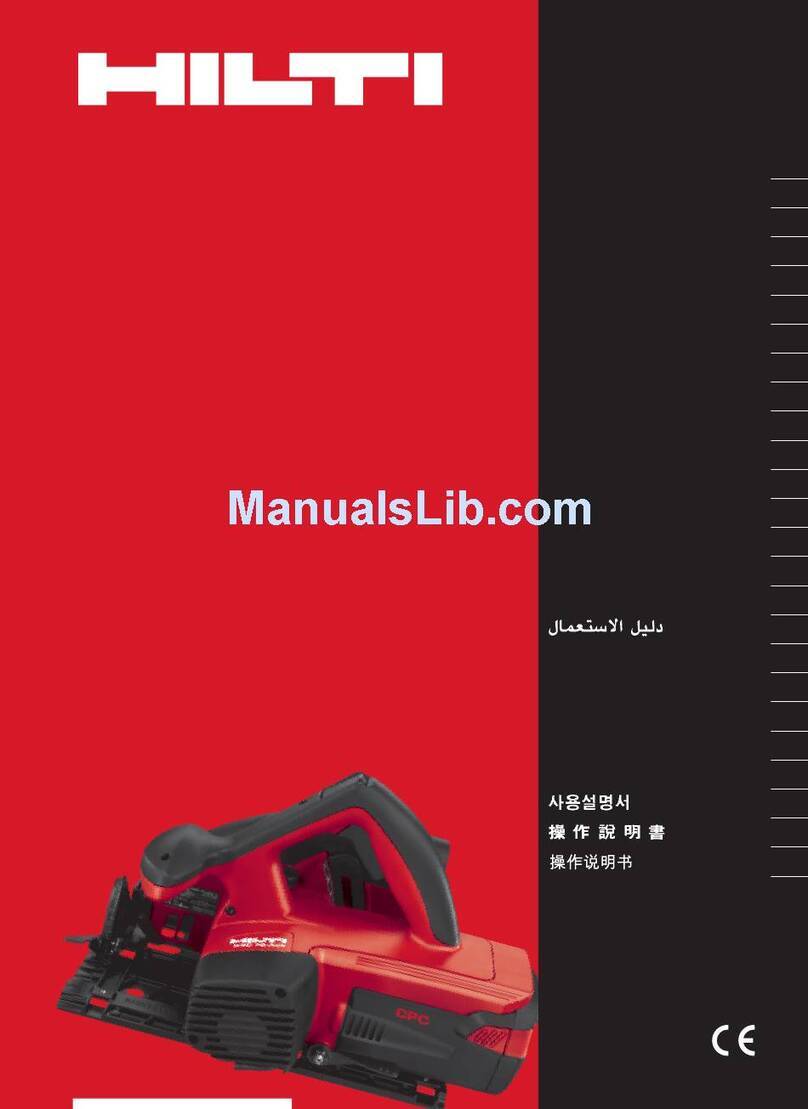
Hilti
Hilti WSC 70-A36 User manual

Hilti
Hilti DSH 900 User manual
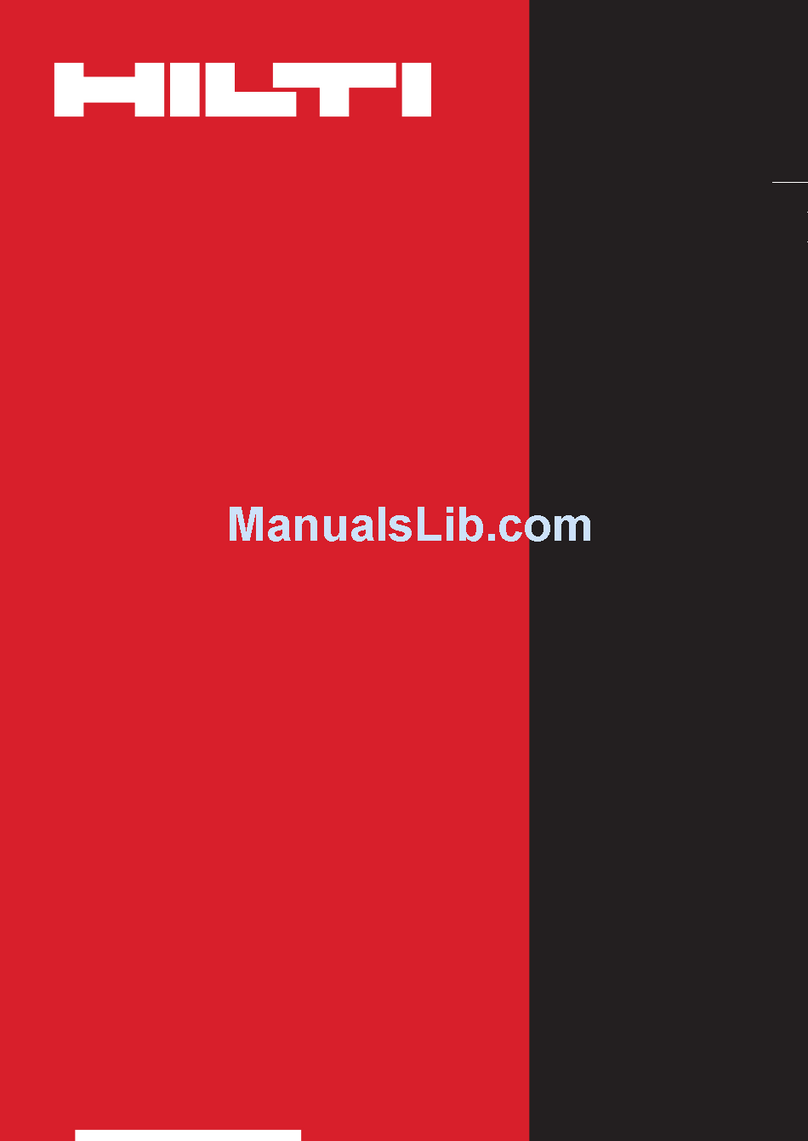
Hilti
Hilti WSC 267-E User manual
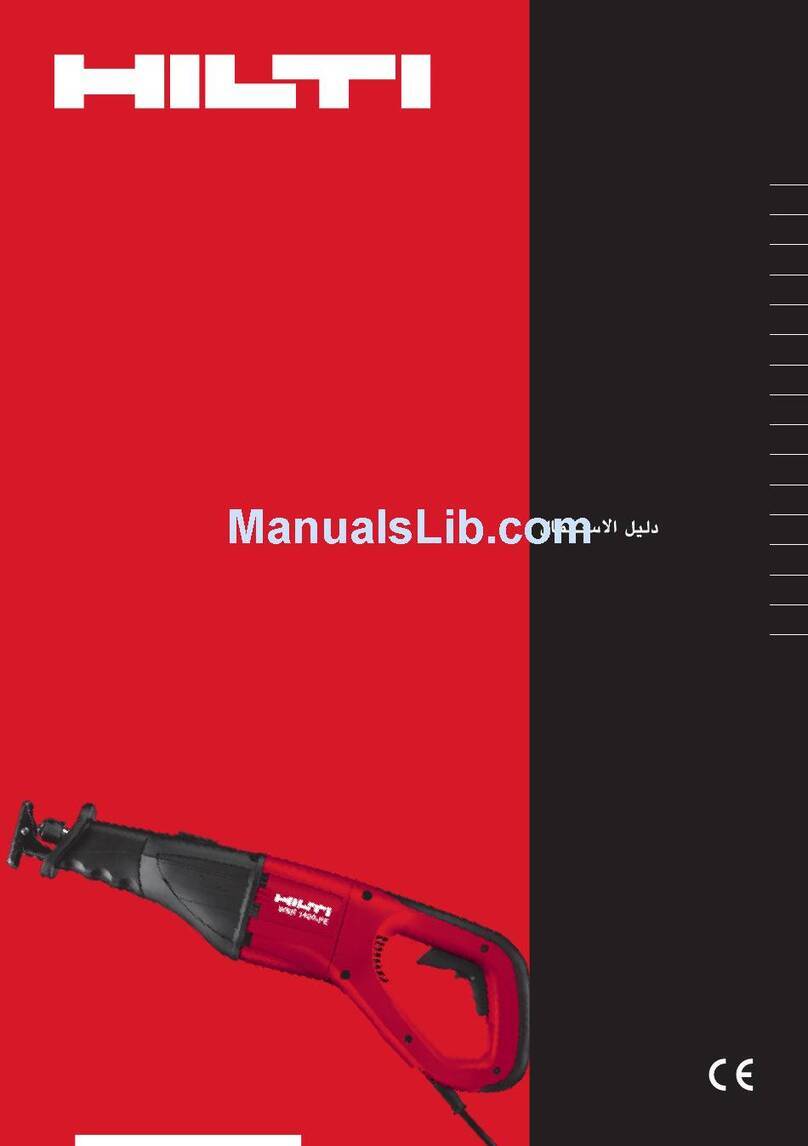
Hilti
Hilti WSR 900-PE User manual

Hilti
Hilti WSJ 750-ET User manual
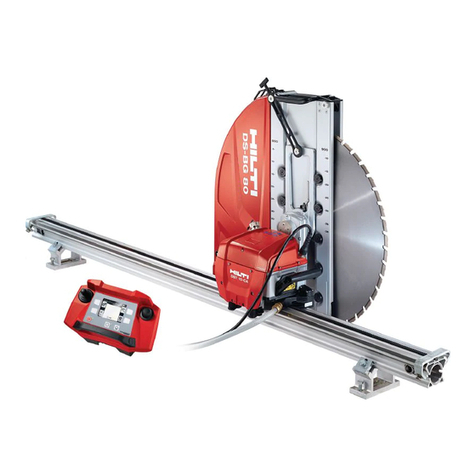
Hilti
Hilti DST 10-CA User manual

Hilti
Hilti SC 60W-A36 User manual

Hilti
Hilti WSC 85 User manual
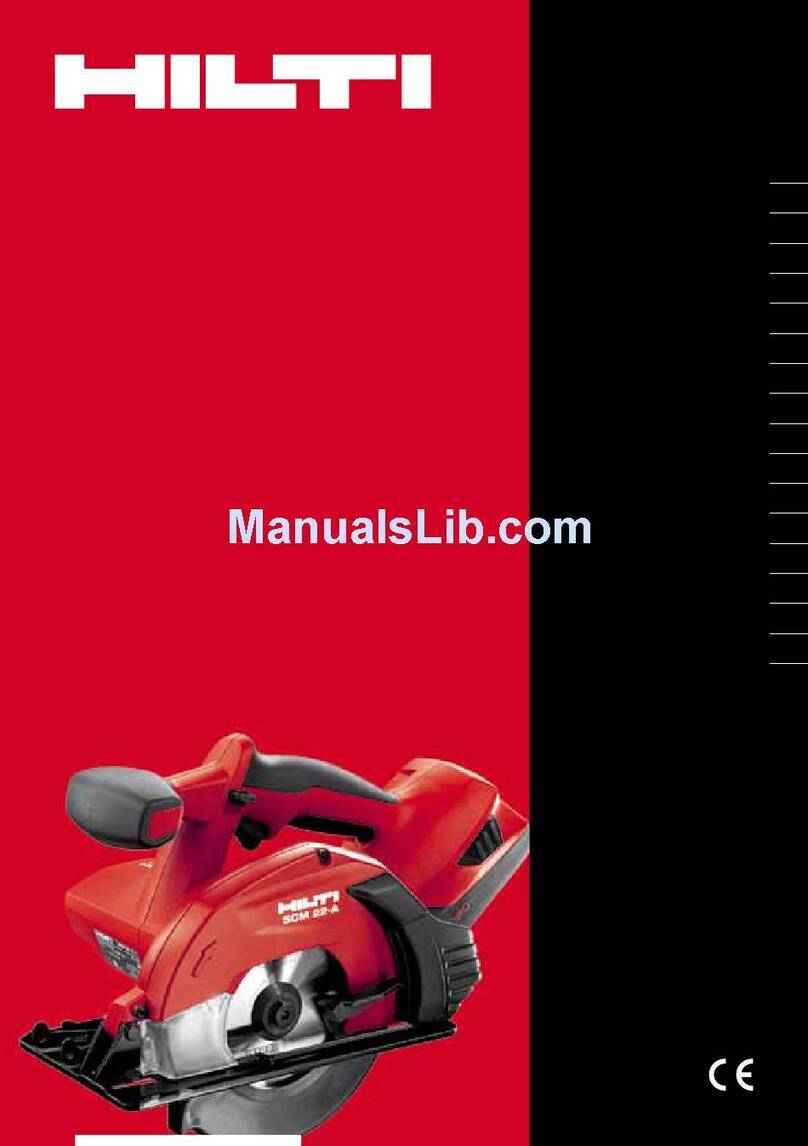
Hilti
Hilti SCM 22-A User manual

Hilti
Hilti DCH 300 User manual

Hilti
Hilti Nuron DSH 600-22 User manual
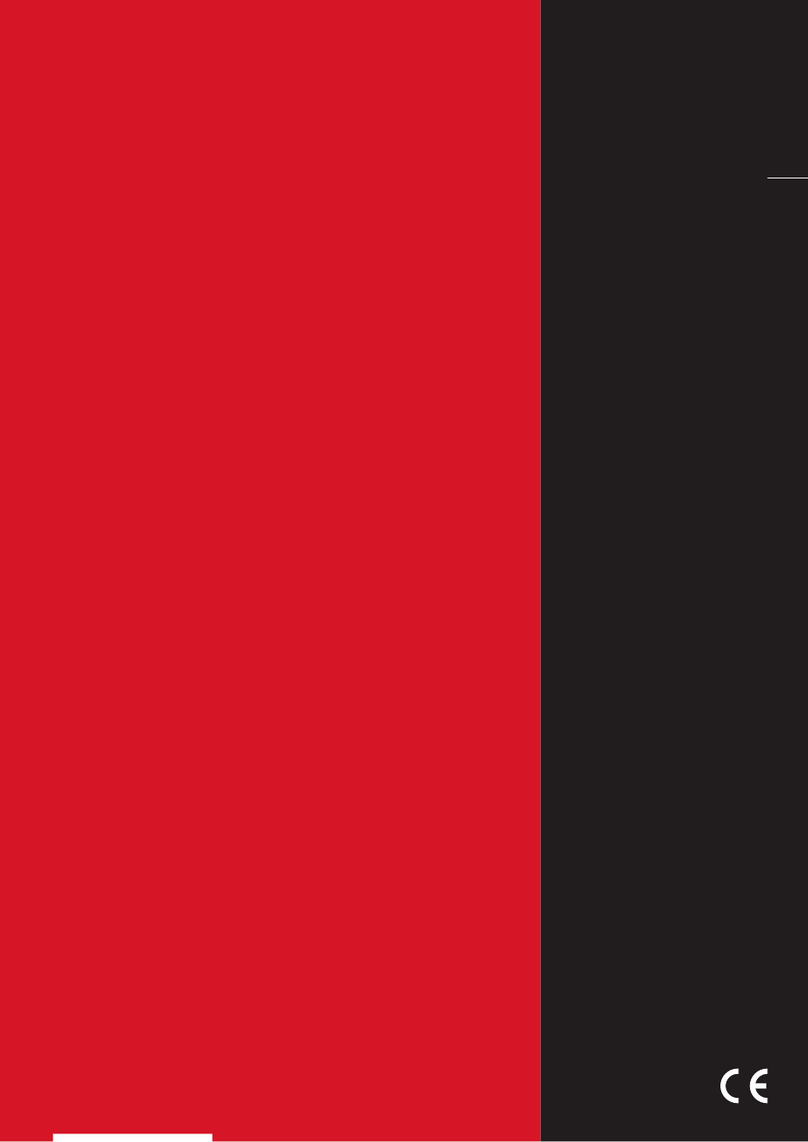
Hilti
Hilti DSW 3018-E User manual
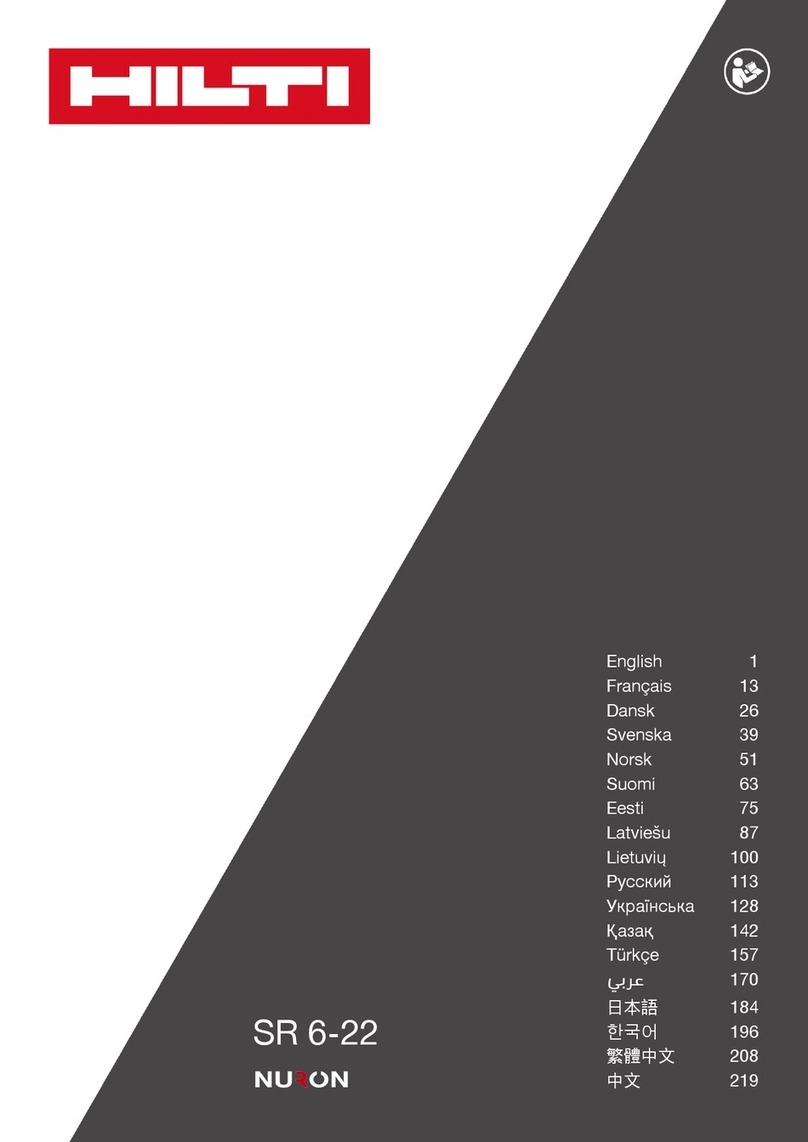
Hilti
Hilti NURON SR 6-22 User manual
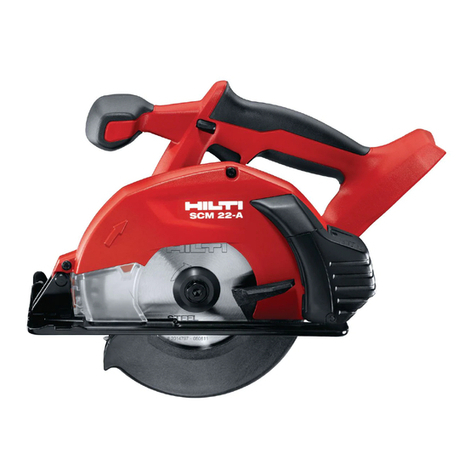
Hilti
Hilti SCM 22-A User manual
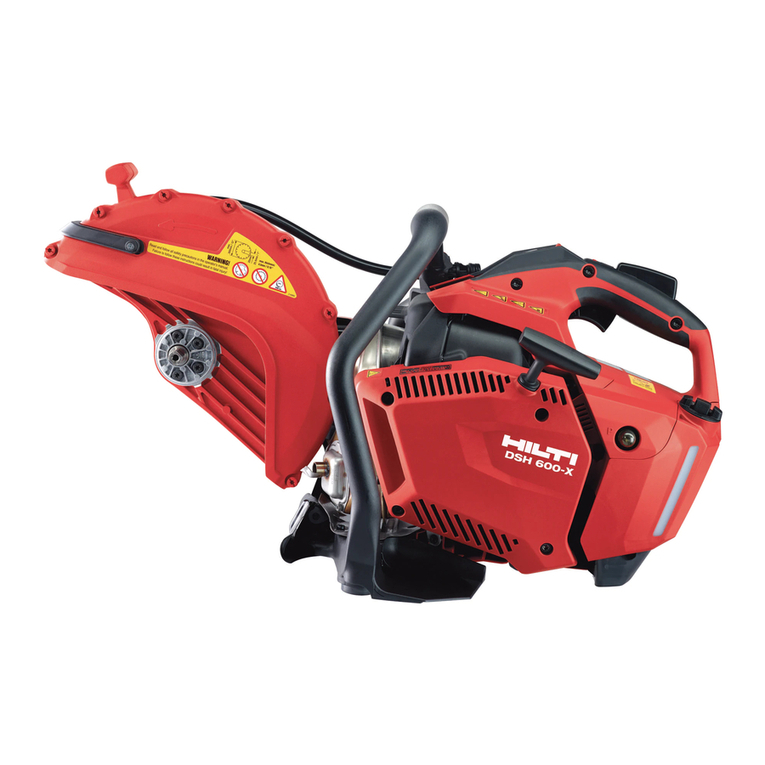
Hilti
Hilti DSH 600-X User manual
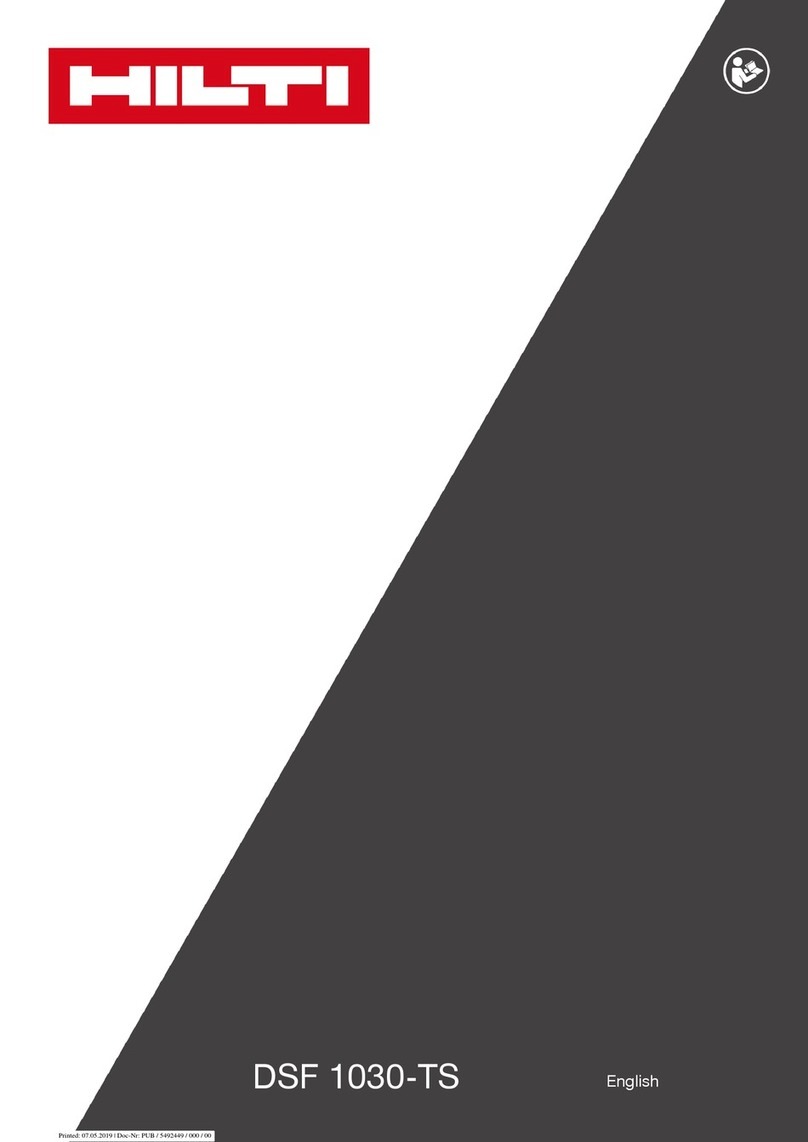
Hilti
Hilti DSF 1030-TS User manual

Hilti
Hilti Nuron DSH 600-22 User manual

Hilti
Hilti SC 5ML-22 User manual

Hilti
Hilti Nuron DSH 600-22 User manual


